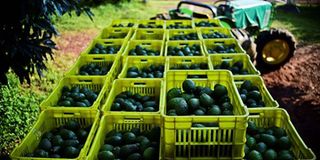Kenya exports to EAC fall for third year

What you need to know:
- Data shows that Kenya’s trade with its neighbours slowed, with its earnings from South Sudan declining by the biggest margin. The sustained drop has been blamed on the performance of the country’s manufacturing sector, amid persistent trade disputes with Tanzania.
- Uganda, Kenya’s biggest regional market recorded an almost flat growth in what it buys from Kenya, at $619 million.
Kenya’s exports to the East Africa region continued to fall last year, fetching $1.29 billion, a 2.5 per cent drop from $1.31 billion in 2017.
The sustained drop has been blamed on the performance of the country’s manufacturing sector, amid persistent trade disputes with Tanzania, one of the region’s biggest markets which, ironically, imported more last year.
Data released by the Kenya National Bureau of Statistics on Thursday shows that Kenya’s trade with its neighbours slowed, with its earnings from South Sudan declining by the biggest margin — 22.6 per cent — from $167 million in 2017 to $130 million in 2018.
However, according to the 2019 Economic Survey, trade with Tanzania rose by 4.3 per cent to $298 million, with almost similar rise of its earnings from Rwanda to stand at $178 million from $171 million in 2017.
Uganda, Kenya’s biggest regional market recorded an almost flat growth in what it buys from Kenya, at $619 million.
This is, however, better than the drop the country recorded in its exports to Kampala last year, down to $618 million.
Kenya also recorded a drop in its exports to Somalia, declining from $197 million in 2017 to $151 million last year, while exports to the Democratic Republic of Congo decreased by 19.6 per cent from $189 million in 2017 to $152 million in 2018.
“Export earnings from Egypt grew by 5.8 per cent to $201 million in 2018 with those from South Africa seeing a significant improvement by 59 per cent to $44 million in 2018, largely on account of re-exports of machinery to the country,” KNBS said in the survey report.
FTA agreement
This could also mean Kenya is making use of the tripartite FTA agreement under the Common Market for Eastern and Southern Africa to increase its foothold in these two countries even as it cuts down imports from their markets.
The survey further states that imports by Nairobi from the East African region increased by 12.4 per cent to $685 million in 2018 and contributed 33.3 per cent of the value of imports from Africa.
“The value of imports from Uganda was largely driven by increased imports of maize, sugar, milk and animal feeds, which rose by 17.6 per cent to $494 million, while imports from Tanzania grew from $172 million in 2017 to $178 million in 2018,” the report said.
Comesa
The county’s total exports to the Comesa member states declined by 3.8 per cent from $1.66 billion in 2017 to $1.6 billion in 2018.
This saw Nairobi spend on imports from Egypt and South Africa, key members of the Comesa grow by 2.7 per cent and 4.6 per cent to $363 million and $647 million respectively, with the value of imports from Zambia, Mauritius and eSwatini declining by 11.0, 16.6 and 23.2 per cent to $69 million, $61 million and $86 million, respectively, in 2018.
Asia and the Far East
Nairobi also saw its expenditure on imports from Africa rise by 2.7 per cent from $2 billion in 2017 to $2.06 billion in 2018, accounting for 11.7 per cent of total imports.
Overall, Kenya saw its total export earnings rise by 3.2 per cent to $6.13 billion in 2018, mainly due to an 11.4 per cent growth in exports to Asia.
The value of exports to Asia amounted to $1.81 billion and accounted for 29.5 per cent of the total exports in 2018.
The total exports to the Far East rose by 5.5 per cent to $1.17 billion in 2018, accounting for 64.8 per cent of total export earnings from Asia.
“The increase in exports to Far East was largely due to significant improvement in exports to India, China, Thailand and Afghanistan.
“Domestic exports of dried leguminous vegetables to India rose by more than five times, while exports of aluminium waste and wool also recorded notable increase, leading to an increase in total exports to the country,” KNBS said.
However, total exports to Pakistan, one of the region’s biggest customers for its tea, declined from $641 million in 2017 to $594 million in 2018, on account of a 7.5 per decline in the value of tea exports.
The Middle East
“The value of exports to the Middle East grew by 24 per cent to $637 million, largely attributable to a significant increase in export to the United Arab Emirates and Saudi Arabia.
“The growth in export earnings from the UAE was largely on account of a 5.2 per cent increase in tea exports, accounting for 46.8 per cent of domestic exports to the country,” the report said.
Europe
Nairobi also saw its exports to the European Union increase by 4.4 per cent, which accounted for 21.4 per cent of total exports at $1.31 billion in 2018, mainly driven by improvements in the exports earnings from the Netherlands and the United Kingdom, which rose to $464 million and $402 million respectively, on account of increased exports of horticultural products in 2018.
Despite cut flowers accounting for the bulk of total exports to the Netherlands, the largest increase was recorded in domestic exports of avocados, which more than doubled in 2018.
However, Nairobi’s exports to Germany fell by 4.9 per cent $112 million mainly due to a decline in the value of coffee exported to the country.
The Americas
From its trade with the Americas, Nairobi earned $473 million, mainly comprising export earnings of apparel and clothing accessories, but it saw a decline in what it sells to Canada of 13.6 per cent to $31 million in 2018 due to a decline in re-export of jet fuel.




